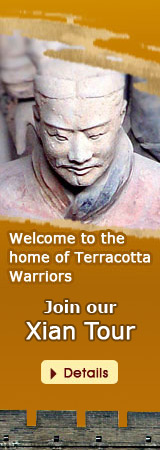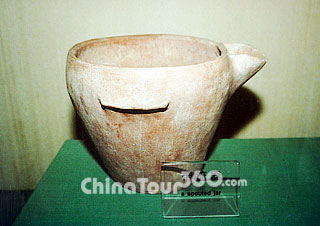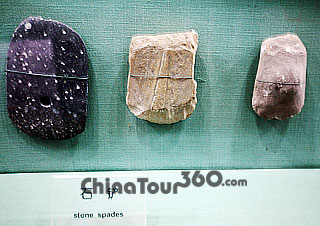Located in the eastern suburb of Xian, Banpo Museum is the first prehistoric museum established in China. It is a typical settlement of matrilinear clan commune of Neolithic Period. As the precious cultural heritage in China, it plays an important role in researching the history of primitive society of China.
Covering an area of approximate 50,000 square kilometers (19,305 square miles), Banpo site can be divided into three areas, residential area, pottery-making area and cemetery area. At the center of the settlement was a 160 square meters (191 square yards) room that was encircled by some smaller rooms. The layout of the rooms speaks volumes for the unity of the clan. A 300-meter (328 yards) long ditch around the village was used to keep the wild animals from attacking. To the east was a ceramic-making area and to the north was the cemetery district. The excavation were of 45 ruins of old houses, 2 pens, 200 caves, 6 kilns, 250 cemeteries, lined up in regular order, great amounts of daily necessities and manufacturing tools when it was discovered in 1953.
During Neolithic period, humans were able to make some simple tools of stone and wood, which marked a great advance for human development. It was the truth that women were the main labor force in the family responsible for pottery making, weaving and family raising, whereas, men mainly went in for fishing.
The 4,500 square meters (5,381 square yards) exhibit area of Banpo Museum is divided into two Exhibition Halls and a Site Hall. The first exhibition hall mainly displays the tools of production including stoneware, fishing tools, bone needles and spinning wheel. In the second exhibition hall, all sorts of antiques that could reflect the social life of primitive Banpo people are exhibited. The Site Hall is of high archaeological value, because this 3,000 square meters (3,588 square yards) hall is part of the residential area of the primitive people, the remains of the old houses, cemeteries, kilns, potteries fully manifest the hardness they suffer from in advancing the society.
Banpo Site had been lying underground for about 6,000 years before its discovery in 1953. The excavations showed that people mainly took use of ground tools made of stone. Primitive farming is the basic style to develop the economy. Daily utensils were pottery with the geometrical figures or animal patterns painted on. This kind of culture was initially discovered in Yangshao Village in Henan Province in 1921, thus it was called Yangshao Culture. Around twelve different kinds of markings or symbols have been found on pottery fragments or on vessels at the site, of which, the most famous should be the one of human face with fish figures. The pattern that atop the human head was a triangular bun with two small fishes beside the corners of the mouth reflected the relationship of human and nature, and the bond of Banpo people with fish. It was speculated that fish was possibly regarded as the totem at that time.
The precious cultural relics excavated in Banpo Site accounts for its high rank in China. Its discovery once again demonstrates the great power of ancient China.
![]() Entrance Fee:
Entrance Fee:
CNY 35 (Mar. to Nov.)
CNY 25 (Dec. to Feb.)
![]() Opening Hours: 09:00 - 17:00
Opening Hours: 09:00 - 17:00
![]() Bus Routes: Take Bus No. 11, 15, 42, 105, 231, 406 or 913 and get off at Banpo stop.
Bus Routes: Take Bus No. 11, 15, 42, 105, 231, 406 or 913 and get off at Banpo stop.











